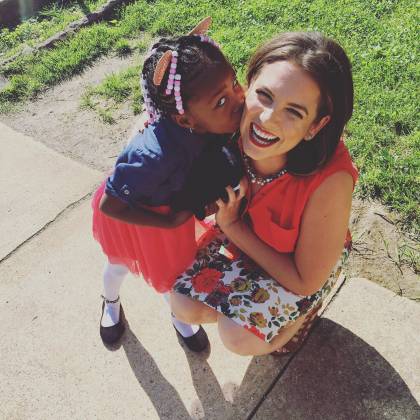The very idea of wrangling a class of 39 6-year-olds is enough to trigger a wave of panic for most people. Now imagine that roughly three-quarters of those kids are either ESL learners or need extra attention for learning disabilities, and many of them are dealing with trauma, abuse, and the shrapnel of poverty. Not to mention, they're forced to learn in a derelict school building with asbestos lurking in the tiles and no heat or air conditioning.
Danna Thomas, Ed '13 (MS), faced these conditions daily as a kindergarten teacher in Baltimore City. "I would think about the stories my students and their families shared with me—trauma, mental illness, abuse—and I would lose sleep at night," she says. After nights racked with stress, she'd head back into a classroom that felt constantly in crisis mode. And she knew she wasn't alone—her colleagues often shared similar concerns about the growing needs of students and the dwindling resources teachers had to meet them. "I felt so unsupported, especially emotionally unsupported, and I felt like I had to do something," she says.

Image caption: Danna Thomas’ Happy Teacher Revolution movement stems from her own experiences teaching in Baltimore.
Image credit: Courtesy of Danna Thomas
In 2015, exasperated, and "out of pure desperation," Thomas founded Happy Teacher Revolution, a movement to serve as the support net stressed-out teachers need. At group meetings, teachers come together to share the challenges they're facing and wellness strategies that have worked for them, and to receive training on social-emotional and trauma-informed practices for educators. The thesis is simple: Happier, healthier teachers make for happier, healthier students.
Teacher stress isn't a new problem, but research suggests it's getting increasingly worse for the current generation of educators. A 2017 survey by the American Federation of Teachers reported a sharp jump in self-reported teacher stress from just two years earlier. "When you talk about urban schools and particularly first-year teachers, retention rates are really low," says Ileana Gonzalez, an assistant professor at the Johns Hopkins School of Education and coordinator of its School Counseling Fellows Program. The problem is particularly pronounced when it comes to teachers of color, she adds. "We see that oftentimes they don't stick around too long, for a number of reasons: class size, lack of support, lack of mentorship, differing student learning needs, different challenges associated within a community."
Through her work with Happy Teacher Revolution, Thomas has heard stories from teachers about facing empty desks in their classrooms after losing a student to gun violence; helping students cope with the trauma of violently losing a loved one; even a story about a student showing up to class with dried blood on his sneakers from walking past a dead body on the way to school.
For the teachers tasked with caring for those kids, the trauma can be contagious, yet teachers are rarely asked how they're holding up—let alone offered resources and support. Thomas offers up an analogy. "Just like on an airplane, you have to put the oxygen mask on yourself before supporting children and those around you," she says. "We think of teachers' primary responsibility as educating students and providing them with academic instruction," Thomas says. "But it's not just academics. It's supporting him or her as a person—supporting students with social and emotional learning, helping them tap into grit and tenacity, and equipping students with life lessons far beyond the walls of your classroom."
View this post on Instagram
That can make all the difference for students—especially those who are struggling, as Thomas once was. When she was in high school and college, she grappled with mental illness, battling anxiety, depression, and panic attacks—at one point even contemplating suicide. "I did a really good job of hiding that darkness from my parents and hiding it from my friends, but I couldn't hide it from my teachers," she says. They were able to pick up on subtle shifts in Thomas' behavior and offer her an oxygen mask, largely because they were well-supported, she says. "My teachers were my first responders in every sense of the word," Thomas says. "I probably wouldn't be talking to you today if it weren't for them."
After seven years as a teacher, Thomas left the classroom to join the 2018–19 cohort of the Johns Hopkins Social Innovation Lab, a six-month accelerator program that provides funding and mentoring to business and nonprofit leaders. She's training Happy Teacher "revolutionaries" to create teacher support networks in schools across the globe. The movement currently includes schools in 17 states, plus more internationally. "Our largest Happy Teacher Revolution site isn't even in the United States," Thomas says. "It's in Dakar, Senegal."
Next, Thomas wants to put hard science behind the self-care program. This year, she's partnering with researchers across the country including doctoral students, academics, and education research groups to measure the efficacy of Happy Teacher Revolution based on metrics like teacher retention, sick days taken, professional sustainability, and, of course, happiness for both students and teachers. Her biggest realization so far? "Happiness has a ripple effect just like stress does. If there's a stressed-out teacher, it ripples—the students, other teachers, and loved ones around them are affected by that stressed-out, unhappy teacher." But Thomas has also seen the same ripple effect with happy teachers, in Senegal, Texas, Tennessee, Oregon, and her own district in Baltimore. "Happy Teacher Revolution isn't just helping this individual teacher," she says. "We're helping the village around that teacher—and that's really beautiful."
Posted in Health, Politics+Society








